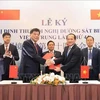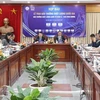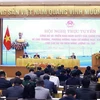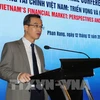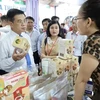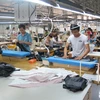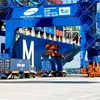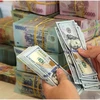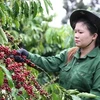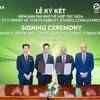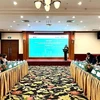The Regional Comprehensive Economic Partnership (RCEP), which is under negotiation, would have a positive impact on Vietnam's economy but would create challenges as well, a workshop heard on October 24 in Ho Chi Minh City.
RCEP is a free-trade agreement currently between 10 ASEAN countries and the six countries with which ASEAN has existing free trade agreements (Japan, the Republic of Korea, Australia, New Zealand, India and China).
The RCEP targets to create a broad and deep engagement with significant improvements over the existing ASEAN+1 FTAs. It also seeks to achieve a modern and comprehensive trade agreement among members.
The core of the negotiating agenda covers trade in goods and services, investment, rule of origin, economic and technical cooperation and dispute settlement.
Claudio Dordi, the technical assistance team leader of EU-MUTRAP, said the agreement would help Vietnam better integrate with the Asian value chain in the production network.
However, if Korea, Japan, China and India become part of this free trade agreement, "exports from Vietnam to these countries would face competition from Chinese products," he said.
"This is quite a big problem for Vietnamese exports, so this challenge should be taken into consideration during negotiations," he added.
"Currently, under the framework of ASEAN+1 with Japan and the Japan-Vietnam bilateral free trade agreement, Vietnam can export duty-free garments to Japan, while exports of the same products from China to Japan bear a custom duty of 10, 15 or 20 percent."
Similarly, Vietnamese footwear exported to Japan bears a limited tariff of under five percent, while duties on Chinese footwear imports are 20-30 percent.
However, under RCEP, Chinese exports would also benefit from preferential custom duties.
Thus, Vietnamese exporters would face fierce competition with China in the Japanese market.
Vietnam, Cambodia, Myanmar and Laos would likely gain more from the ASEAN+1 agreements, he said.
However, the RCEP would provide opportunities for Vietnam to further integrate into the regional value chain, and promote the development of a national support industry, as well as enable the country to benefit from rules of origin, he said.
Currently, if Vietnam imports fabric from China to produce garments and exports to Japan and Korea, the products would not enjoy tariff incentives.
However, this could be changed under RCEP.
He suggested that Vietnamese negotiators pay more attention to rules of origin.
With the number of free trade agreements Vietnam is negotiating, there would be huge opportunities for Vietnamese companies to expand exports.
To capitalise on these opportunities, firms must create suitable business strategies, focus more on building brands for their products, develop distribution systems, and have a better knowledge of their targeted export markets.
He suggested that Vietnamese enterprises keep up with the status of the negotiations carried out by the Government, and relay their concerns.
Only about half of Vietnamese enterprises understand and use the opportunities afforded by existing FTAs, while most foreign-invested enterprises have taken full advantage, according to Lam Thi Quynh Anh, head of the division of bilateral cooperation, information and propaganda under the National Committee for International Economic Cooperation Office (NCIEC).
In total, the group of 16 nations includes more than three billion people and accounts for about half of world trade.
If negotiated successfully, RCEP would create the world's largest trading bloc and have major implications for Asia and the world economy, said An The Dung, chief of NCIEC.
The workshop was organised by NCIEC, Asia-Pacific Market Department and the HCM City WTO Centre. It was sponsored by EU-MUTRAP.-VNA
RCEP is a free-trade agreement currently between 10 ASEAN countries and the six countries with which ASEAN has existing free trade agreements (Japan, the Republic of Korea, Australia, New Zealand, India and China).
The RCEP targets to create a broad and deep engagement with significant improvements over the existing ASEAN+1 FTAs. It also seeks to achieve a modern and comprehensive trade agreement among members.
The core of the negotiating agenda covers trade in goods and services, investment, rule of origin, economic and technical cooperation and dispute settlement.
Claudio Dordi, the technical assistance team leader of EU-MUTRAP, said the agreement would help Vietnam better integrate with the Asian value chain in the production network.
However, if Korea, Japan, China and India become part of this free trade agreement, "exports from Vietnam to these countries would face competition from Chinese products," he said.
"This is quite a big problem for Vietnamese exports, so this challenge should be taken into consideration during negotiations," he added.
"Currently, under the framework of ASEAN+1 with Japan and the Japan-Vietnam bilateral free trade agreement, Vietnam can export duty-free garments to Japan, while exports of the same products from China to Japan bear a custom duty of 10, 15 or 20 percent."
Similarly, Vietnamese footwear exported to Japan bears a limited tariff of under five percent, while duties on Chinese footwear imports are 20-30 percent.
However, under RCEP, Chinese exports would also benefit from preferential custom duties.
Thus, Vietnamese exporters would face fierce competition with China in the Japanese market.
Vietnam, Cambodia, Myanmar and Laos would likely gain more from the ASEAN+1 agreements, he said.
However, the RCEP would provide opportunities for Vietnam to further integrate into the regional value chain, and promote the development of a national support industry, as well as enable the country to benefit from rules of origin, he said.
Currently, if Vietnam imports fabric from China to produce garments and exports to Japan and Korea, the products would not enjoy tariff incentives.
However, this could be changed under RCEP.
He suggested that Vietnamese negotiators pay more attention to rules of origin.
With the number of free trade agreements Vietnam is negotiating, there would be huge opportunities for Vietnamese companies to expand exports.
To capitalise on these opportunities, firms must create suitable business strategies, focus more on building brands for their products, develop distribution systems, and have a better knowledge of their targeted export markets.
He suggested that Vietnamese enterprises keep up with the status of the negotiations carried out by the Government, and relay their concerns.
Only about half of Vietnamese enterprises understand and use the opportunities afforded by existing FTAs, while most foreign-invested enterprises have taken full advantage, according to Lam Thi Quynh Anh, head of the division of bilateral cooperation, information and propaganda under the National Committee for International Economic Cooperation Office (NCIEC).
In total, the group of 16 nations includes more than three billion people and accounts for about half of world trade.
If negotiated successfully, RCEP would create the world's largest trading bloc and have major implications for Asia and the world economy, said An The Dung, chief of NCIEC.
The workshop was organised by NCIEC, Asia-Pacific Market Department and the HCM City WTO Centre. It was sponsored by EU-MUTRAP.-VNA
